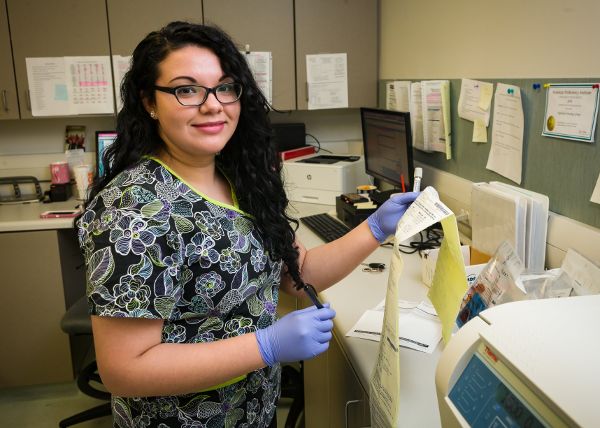Overview
Uterine cancer begins when cells in the uterus (womb) start to grow uncontrollably. A tumor can form when more cancer cells develop, and it can spread to other areas of the body.
The uterus is a hollow, muscular organ of the female body in which the fetus develops during pregnancy. The lining of the uterus (endometrium) changes throughout the menstrual cycle, thickening and shedding in a cycle governed by the hormones estrogen and progesterone. Nearly all uterine cancers start in the endometrial layer. As it grows and spreads, the cancer becomes more advanced.
Types of uterine cancer include:
- Endometrial carcinoma (Over 95% of uterine cancers are of this type)
- Adenocarcinoma
- This is the most common type of endometrial cancer
- Carcinosarcoma
- Squamous cell carcinoma
- Undifferentiated carcinoma
- Small cell carcinoma
- Transitional carcinoma
- Adenocarcinoma
- Uterine sarcoma
- Uterine leiomyosarcoma (LMS)
- Endometrial stromal sarcoma (ESS)
- Undifferentiated sarcoma
Symptoms
Often uterine cancer causes abnormal vaginal bleeding (a change in menstrual cycle, bleeding between regular periods, or bleeding after menopause), the most common symptom of uterine cancer. It is important to note that abnormal vaginal bleeding can be caused by a number of other non-cancerous causes, but it is important to be checked by a medical professional with this symptom.
Other symptoms of uterine cancer may include:
- Other vaginal discharge (not bloody)
- Pelvic pain
- Unintentional weight loss
- Feeling a mass, or a feeling of fullness in the belly or pelvis
Risk Factors
Hormone-related factors are a major contributor to the development of many uterine cancers. Many of these risk factors affect estrogen and progesterone levels, which normally fluctuate throughout the menstrual cycle to produce periods and keep the endometrium healthy. Increased estrogen levels relative to progesterone can increase the risk of developing uterine cancer. Factors that can affect estrogen, and therefore uterine cancer risk, include:
- Estrogen (hormone replacement) therapy increases risk unless progesterone is administered during the same course of treatment (which is known as combination hormone therapy).
- The use of oral contraceptives lowers the risk of endometrial cancer, with protection increasing with longer use.
- A higher number of total menstrual cycles (starting menstruation early or menopause late) increases risk.
- Pregnancy increases relative levels of progesterone and therefore protects against uterine cancer.
- Carrying more fat tissue, which can convert certain other types of hormones into estrogen, increases uterine cancer risk. Endometrial cancer occurs twice more often in overweight women, and three times more often in obese women, than in healthy-weight women.
- The breast cancer treatment drug tamoxifen can increase risk of uterine cancer, but the risk is low, and should be weighed against the benefits of the drug in the treatment of breast cancer.
- Certain ovarian tumors produce estrogen, and this hormone production is not regulated by the body in the same way as normal hormone production from the ovaries. High estrogen levels resulting from this overproduction can lead to endometrial cancer.
- Polycystic ovarian syndrome (PCOS) results in abnormal hormone levels, including an increase in estrogen relative to progesterone, and thereby an increase in endometrial cancer risk.
- Intrauterine device (IUD) use reportedly lowers uterine cancer risk, though the research about non-hormonal and newer types of IUDs is limited.
Other (non-hormonal) risk factors include: advancing age, diet (especially diets high in fatty foods), low physical activity or more time sitting, diabetes, family history of endometrial cancer or a certain type of colon cancer, breast or ovarian cancer, endometrial hyperplasia (overgrowth of the endometrium), or pelvic radiation therapy. The abnormal gene associated with a type of eye cancer called retinoblastoma also increases the risk of uterine leiomyosarcoma (LMS), and uterine sarcomas are more common in African-American women than in white or Asian women.
Prevention
While some risk factors, such as age, race, co-occurring conditions, and total menstrual cycles cannot be controlled, there may be some things you can do to lower your risk of uterine cancer:
- Maintain a healthy weight with a healthy level of body fat
- Regular physical activity
- If hormone therapy is indicated for you, discuss your options and risks thoroughly with your doctor
- Be proactive in treating endometrial problems including hyperplasia and abnormal bleeding
- Talk to your doctor if you have hereditary nonpolyposis colon cancer (HNPCC or Lynch syndrome)
Diagnosis
If there is a suspicion of uterine cancer, you should be examined by a gynecologist. A detailed medical history and physical exam will be performed. Your doctor will ask questions about your risk factors and family history. The physical exam will include a pelvic exam.
Ultrasound may be used for the doctor to examine the uterus, ovaries, and fallopian tubes. The endometrium may be biopsied to determine whether an abnormality is hyperplasia or cancerous. This biopsy is needed to confirm the diagnosis, and can be performed in the doctor’s office with minimal time and discomfort. Other types of biopsy, including a hysteroscopy and dilation and curettage (D&C), may require anesthesia and a somewhat longer outpatient procedure.
Other imaging tests may be used in addition to the diagnostic tools discussed above. These may include x-rays, MRI, CT, PET, blood tests, and other scoping procedures.
Treatment
The treatment plan will depend on the stage of the cancer, as well as other factors. Our doctors will work closely with you and your family determine the best treatment plan for you. Options for treatment could include:
- Surgery
- Radiation therapy
- Hormonal therapy
- Chemotherapy
Your doctor may decide more than one of these treatment options will be in your best interest. Surgery is the most common treatment option.







